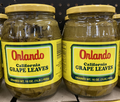 Merchant selling grape leaves in
Damascus (2008) | |
Grape leaves, the leaves of the grapevine plant, are used in the cuisines of a number of cultures. They may be obtained fresh, or preserved in jars or cans. [1] [2] The leaves are commonly rolled or stuffed with mixtures of meat and rice to produce dolma (often, sarma), found widely in the Mediterranean, Caucasus, Balkans, and Middle East. [3] They may also be used in various other recipes and dishes. [4] When cut into smaller pieces they are used as a savory addition to soups that include greens and cabbage. [5]
Nutrition
Canned grape leaves (cooked, salted) are 76% water, 12% carbohydrates, 4% protein, and 2% fat. [6] In a reference amount of 100 grams (3.5 oz), the leaves supply 69 calories and are a rich source (20% or more of the Daily Value, DV) of sodium (119% DV), vitamin A (105% DV), copper (95% DV), pantothenic acid (43% DV), and several other B vitamins and dietary minerals. [6]
Gallery
-
Preserved grape leaves in jars
-
Stuffed grape leaves with yogurt mint sauce
See also
References
- ^ Ingalls, Julia. "The Complicated Comfort Of Syrian Grape Leaves". LAist. Retrieved 2020-12-16.
- ^ Sakellis, Eleni. "Dolamadakia, Stuffed Grape Leaves". The National Herald. Archived from the original on 2021-10-27. Retrieved 2020-12-16.
- ^ Davidson, Alan, ed. (2014). The Oxford Companion to Food. Oxford University Press. p. 879. ISBN 978-0-19-967733-7 – via Google Books.
- ^ "Grape Leaf Herb and Yogurt Pie". The Splendid Table. Retrieved 2020-12-16.
- ^ John Thorne. Simple Cooking. Farrar, Straus and Giroux; 16 November 1996. ISBN 978-0-86547-504-5. p. 183–.
- ^ a b "Grape leaves, cooked, canned and salted (varies by manufacturer)". Nutritiondata.com, Conde Nast and US Department of Agriculture. 2018. Retrieved 17 December 2021.


